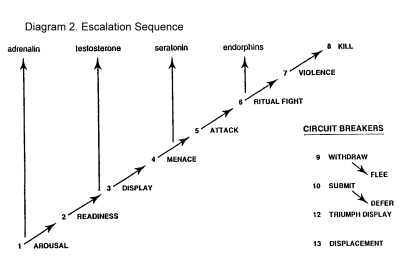The Human Nature of Violence
— By Robin Fox
Part 2.
The assumption that violence is a disease is to make it the analog of diarrhea. But, what if it is in fact an analog of digestion, or of some subprocess like metabolization, ingestion, or excretion? There is no future, in this case, in looking for its "causes" since it doesn't have any. It is just what the organism does as part of its routine of living. One can examine sequences within the routine and see where it fits (what its "functions" are); or, one can ask "ethological" questions about how it came to be there in the first place - evolutionary and adaptational questions. What is it for? What are its adaptational advantages? What survival value does it give the organism? - and so on. But "causal" questions are simply inapplicable.
If we make this analytical mistake when looking at sequences of behavior involving violence at some point, then we will ask, What caused this violence to occur? and expend a lot of mental energy trying to find an answer on the analogy of, Why did diarrhea occur? But if we look at the same sequence in the ethological framework - as we do in "agonistic encounters" between animals of the same species, for example - we can predict fairly accurately when, in the escalation process, violence will occur. It is a natural, expectable, predictable, inevitable part of the process. It is not diarrhea. It is metabolization, if you like.
Whether we like violence or not is not the question here. We are not concerned with evaluating it but with explaining or understanding it. And the causal explanation may simply not be the appropriate one, driven as we are by dislike to look for the cause to remedy the supposed disease.
Diagram 2 shows a typical escalation sequence of behaviors during an agonistic encounter (this was derived from observations on macaque monkeys, but is fairly generalizable across species).
The lowest level (1) is arousal: a rival is sighted. This puts the animal into a state of readiness. It will then move on to a display of some kind: baring teeth, pilo-erection, etc. It will then move menacingly toward its rival.
This may be followed by an attack, which then will develop into a ritualized fight of some kind. This in turn may spill over into real violence and could end in wounding or killing. There are various "circuit breakers," as I have called them: ways out of the sequence if it gets too hot. An animal can withdraw and flee; it can submit and show deference to the rival; it can indulge in seemingly inappropriate "displacement" behavior (grooming, for example); or it can indulge in a triumph display. This latter is only usual when it has won, but it can be used as a bluff: declare victory and go home, as it were.
Also included on this diagram are some of the hormones involved in propelling the sequence, starting with adrenaline, getting a boost from testosterone and serotonin, and ending with a flood of endorphins if successful. (The trick with serotonin is that very low levels seem to be precursors of aggression, but that very high levels are associated with success.


